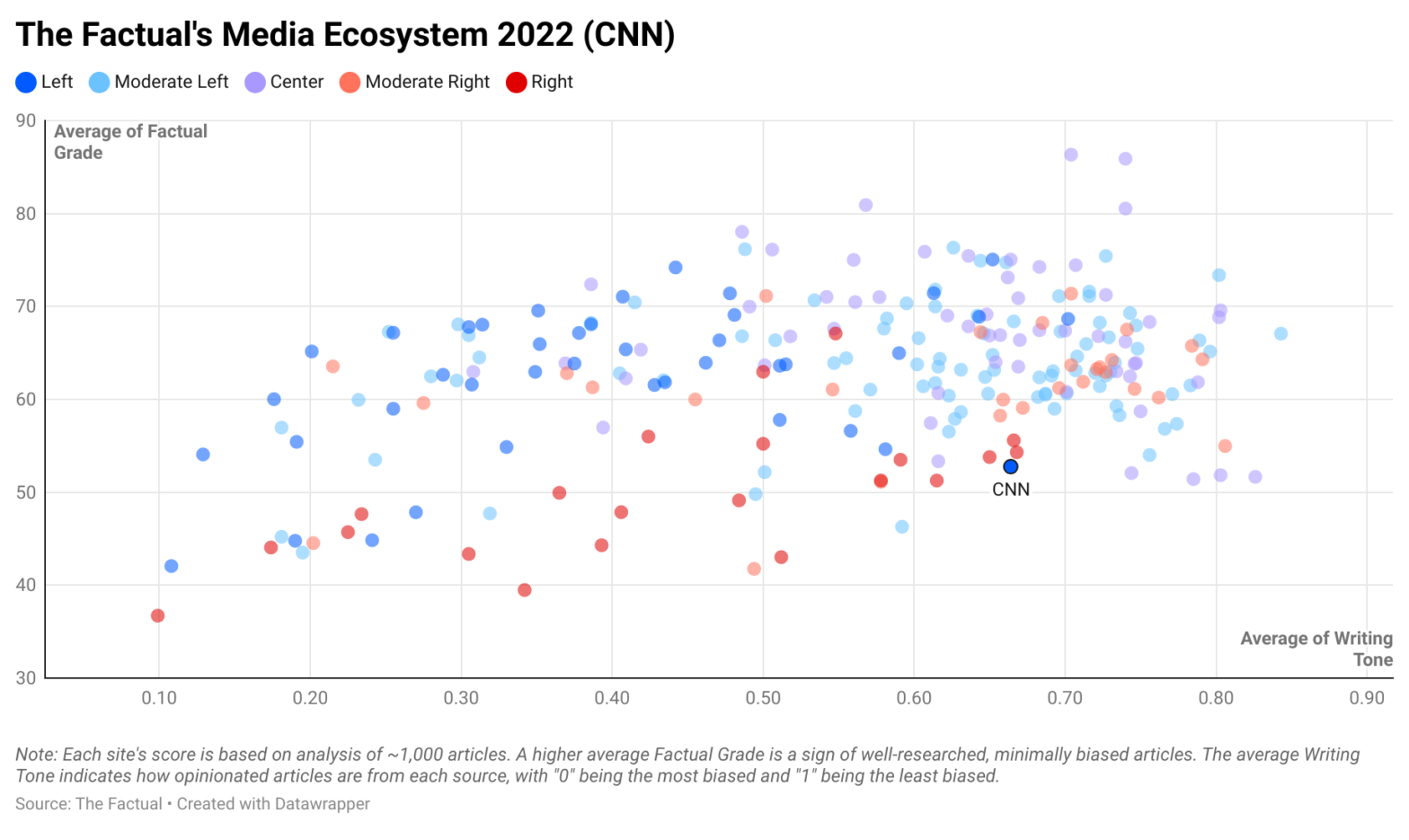CNN has long been a major news source and was one of the pioneers behind round-the-clock news programming. However, the organization has shifted to the left over the last decade. Now, critics argue it has a strong liberal bias that skews its coverage. This leads us to ask two important questions: how reliable is CNN and how biased is its news coverage?
Note: This article is specifically about CNN’s news website, not any of its television programming, unless noted otherwise.
How Does The Factual Rate News Sources?
The Factual analyzes more than 10,000 news stories every day to help readers find the most informative, least-biased articles. Our news-rating algorithm scores each article along four metrics: (1) cited sources and quotes, (2) publication history, (3) writing tone, and (4) author expertise. These scores combine in a weighted average we call a Factual Grade, which ranges from 0–100%. (See our How It Works page to learn more about our algorithm.)
For this study, we analyzed ~1,000 articles each from 240 news sources. The average Factual Grade for the entire dataset was 62.5%. Based on these averages, we can compare the performance of news sites across the media ecosystem.
How Factual Is CNN?
CNN scored an average Factual Grade of 52.8%, placing it in the 13th percentile of our dataset. The site’s low scores can be attributed to several factors, particularly poor sourcing. CNN has a tendency to almost always link to other CNN content rather than external sources. This practice aims to retain web traffic but sacrifices having broad-based evidence from external, high-quality sources.
Like any news source, scores for articles from CNN varied widely depending on the cited evidence and writing tone. For example, some scored 70% or higher, while others scored below 50%.
Please check your email for instructions to ensure that the newsletter arrives in your inbox tomorrow.
How Opinionated Is CNN?
One of the metrics The Factual uses is the Writing Tone, which measures how opinionated the writing is in an article. For this metric, the algorithm looks for signs of subjective commentary (e.g., first person pronouns and unnecessary adverbs), as well as the emotional nature of selected words, and sees how prevalent they are for a given length of text. More neutral text receives higher ratings, with “0” being the most opinionated and “1” being the most neutral.
CNN had an average Writing Tone score of 0.66, placing it in the 64th percentile in our dataset. This suggests that articles from the site include a moderate level of opinionated language. This can be seen in the spread between neutral headlines such as “Asia’s largest bird park to close” and biased headlines such as “Student debt relief is a tourniquet — not a magic bullet.”
What Is CNN's Political Bias?
Together, assessments from media bias organizations indicate that CNN’s news website has a “Left” bias.
AllSides assigns CNN a “Left” bias, based on survey data, editorial review, and over 98,610 community ratings. This rating shifted significantly since 2017, moving from “Center” to “Lean-Left” in March 2018, and to “Left” in November 2020. As one reviewer noted, “CNN uses proper source attribution and good hyperlinks, and often has clear, accurate labels for content,” but is “dominated by anti-Trump/anti-GOP narratives and features few to zero anti-left/anti-Democrat narratives.”
Meanwhile, Media Bias/Fact Check gives CNN a strong “Left” bias rating. Articles are “moderately to strongly biased toward liberal causes through story selection and/or political affiliation” and may “utilize strong loaded words, publish misleading reports, and omit reporting of information that may damage liberal causes.” While CNN receives a “Mixed” score for factual reporting related to TV coverage, the news site “tends to be properly sourced with minimal failed fact checks.
In a recent survey, The Hill found that 47% of respondents ranked CNN as liberal (48% ranked Fox News as conservative).
CNN’s shift to the left has been widely documented by both sides. The Washington Post recently noted CNN’s “emotional” and “opinionated” reporting: “CNN’s new emotional rawness can sound like bias at a network that built its reputation on studiously neutral impartiality.” This shows that even left-leaning sources take issue with CNN’s approach. Such bias was particularly evident in the Trump era; a Harvard study classified 93% of CNN’s online coverage in the first 100 days of the Trump administration as negative.
Who Owns CNN?
AT&T bought CNN in 2018 and made it part of WarnerMedia, a mass media and entertainment conglomerate. Notably, AT&T has few other news assets, which means CNN fits into a portfolio mostly focused on entertainment. In 2017, former AT&T CEO Randall Stephenson wrote that AT&T was “committed to continuing the editorial independence” of CNN. This contrasts with a slide toward “sensationalism” in recent years.
Like other major news sites, CNN relies on ad revenue. In 2020, Variety reported that CNN expected to generate $773.1 million from ads that year, compared to $1.32 billion for Fox News and $723.1 million for MSNBC.
Please check your email for instructions to ensure that the newsletter arrives in your inbox tomorrow.
How to Mitigate Bias
Of course, having a liberal bias does not disqualify CNN from producing factual news. CNN still publishes many factual articles. That said, most news articles have some bias because all authors have some frame of reference within which they describe a story. Political bias ratings are useful in understanding this framing. However, it can be more useful to know how factual an article is based on the cited evidence and whether the tone of writing is objective or opinionated. This is what The Factual Grade ascertains. Reading several highly rated articles across the political spectrum, from highly credible liberal and conservative sources, helps counter the bias of any news source or story.
This article was updated on September 15, 2022 to reflect new data.

